INTRODUCTION
MATERIALS AND METHODS
Animals
Experimental protocol
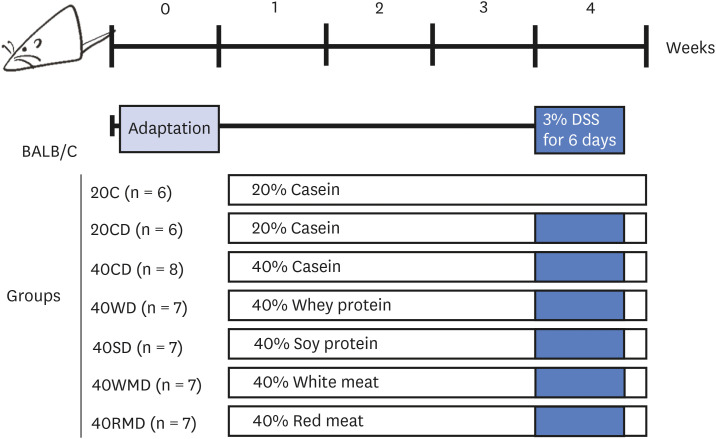 | Fig. 1Schematic representation of experimental design. Female Balb/c mice were divided into 7 diet groups: 20C (control), 20CD, 40CD, 40WD, 40SD, 40WMD, 40RMD. Animals were fed experimental diet for total 4 wk and were received 3% DSS in their drinking water for 6 days on the 3rd wk of the experiment.DSS, dextran sulfate sodium; 20C, 20% casein; 20CD, 20% casein-DSS; 40CD, 40% casein-DSS; 40WD, 40% whey protein-DSS; 40SD, 40% soy protein-DSS; 40WMD, 40% white meat-DSS; 40RMD, 40% red meat-DSS.
|
Table 1
Composition of experimental diets
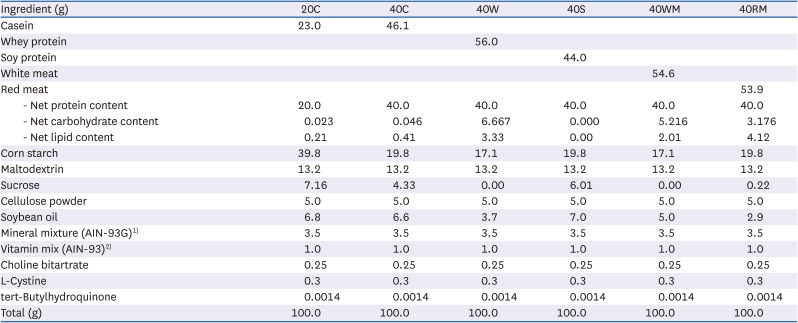
Assessment of disease activity index (DAI)
Sample preparations
Myeloperoxidase (MPO) activity assay
Histopathology of the colorectal tissue
Quantitative reverse transcription polymerase chain reaction (qRT-PCR)
Western blot analysis
Measurement of nitric oxide (NO) levels
Quantification of fecal lipocalin-2 (Lcn-2)
Measurement of fecal ammonia concentration
Determination of SCFAs in feces
Statistical analysis
RESULTS
Colitis activity
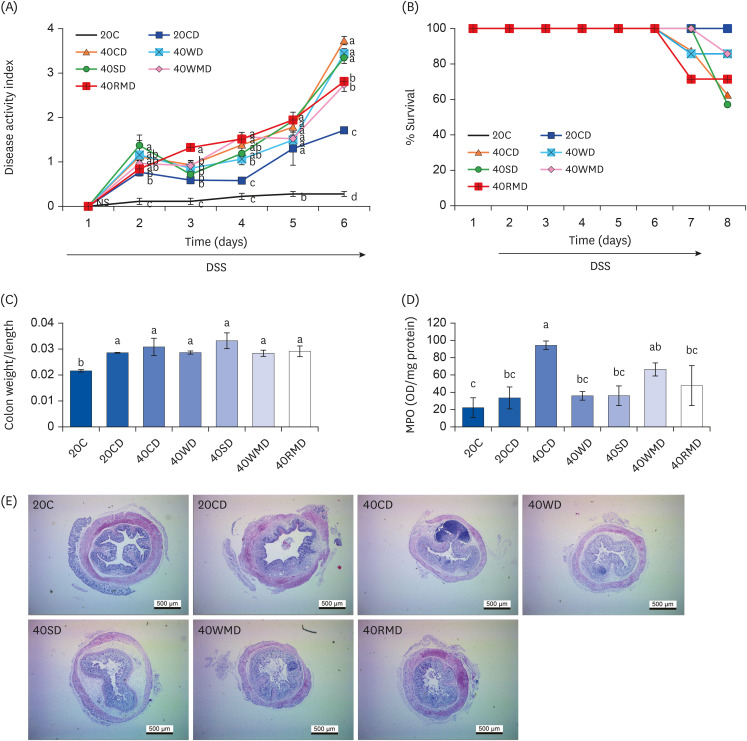 | Fig. 2Effect of various protein sources on the colitis activity. Female Balb/c mice in 20CD, 40CD, 40WD, 40SD, 40WMD, 40RMD group were administered 3% DSS in drinking water for 6 days. Control group received tap water. (A) Disease activity index of mice was monitored during DSS treatment. (B) The survival rate of mice was monitored during and after 2 days of the DSS treatment. (C) The weight and length of entire large intestine was measured and the weight/length ratio was calculated. (D) MPO activities were assayed in colorectal tissue. (E) Colorectal tissue sections were stained with hematoxylin and eosin. Representative histological pictures of mice are shown at 40× magnification. Means with different letters are significantly different at P < 0.05 by Duncan’s multiple range test.20C, 20% casein; 20CD, 20% casein-DSS; 40CD, 40% casein-DSS; 40WD, 40% whey protein-DSS; 40SD, 40% soy protein-DSS; 40WMD, 40% white meat-DSS; 40RMD, 40% red meat-DSS; DSS, dextran sulfate sodium; MPO, myeloperoxidase.
|
Table 2
Effect of various sources of high protein diet on food intake and food efficiency ratio in DSS-induced colitis mouse
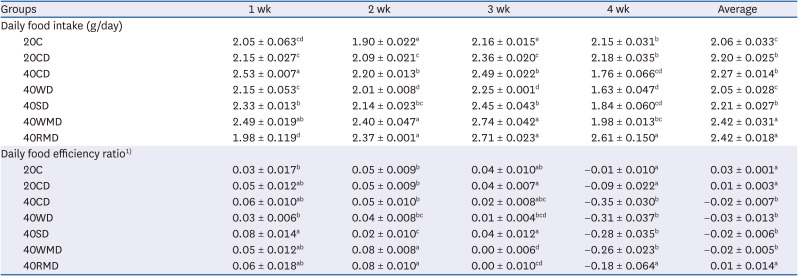
Table 3
Summary of the effects of various dietary protein sources on DSS-induced mouse colitis
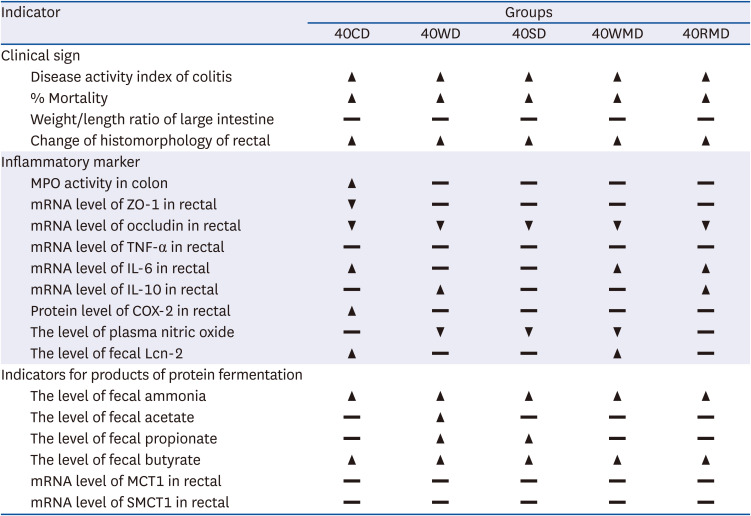
Inflammatory marker expression
 | Fig. 3The changes of inflammatory markers and tight junction protein on various sources of high protein diet fed DSS-induced colitis mice. Acute distal colitis was induced by DSS in drinking water. (A) The mRNA levels of ZO-1 and occludin which function tight junction were measured using RT-PCR. (B) The mRNA levels of TNF-α, IL-6, and IL-10 were measured using RT-PCR. (C) The inflammatory markers were determined by western blot with the appropriate antibodies. Data are presented as representative blots. The protein level of COX-2 was presented. The GAPDH level was used as a control. (D) The level of plasma NO was collected and examined as described in the Materials and Methods. Means with different letters are significantly different at P < 0.05% by Duncan’s multiple range test.mRNA, messenger RNA; ZO-1, zonula occludens-1; GAPDH, glyceraldehyde 3-phosphate dehydrogenase; 20C, 20% casein; 20CD, 20% casein-DSS; 40CD, 40% casein-DSS; 40WD, 40% whey protein-DSS; 40SD, 40% soy-DSS; 40WMD, 40% white meat-DSS; 40RMD, 40% red meat-DSS; TNF-α, tumor necrosis factor alpha; IL, interleukin; COX-2, cyclooxygenase; DSS, dextran sulfate sodium; RT-PCR, reverse transcription polymerase chain reaction.
|
Fecal profile
 | Fig. 4Changes in Lcn-2 and ammonia levels in the feces of DSS-induced colitis mice fed high protein diet of various sources. Mouse feces for each experimental group were collected during the last 3 days of the colitis experiment. (A) The amount of Lcn-2 was measured in the feces of the mouse. (B) The level of ammonia on fecal samples was analyzed as described in the Methods and materials. Means with different letters are significantly different at P < 0.05% by Duncan’s multiple range test.Lcn-2, lipocalin-2; 20C, 20% casein; 20CD, 20% casein-DSS; 40CD, 40% casein-DSS; 40WD, 40% whey protein-DSS; 40SD, 40% soy-DSS; 40WMD, 40% white meat-DSS; 40RMD, 40% red meat-DSS; DSS, dextran sulfate sodium.
|
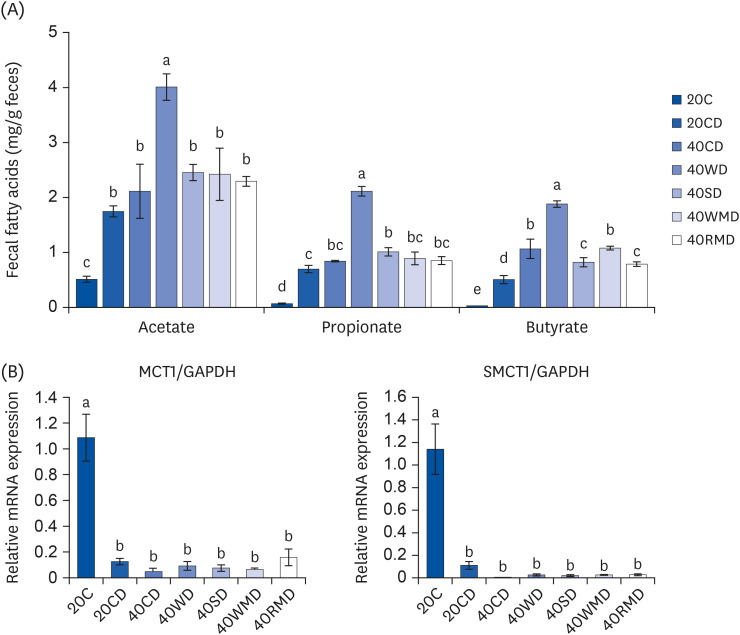 | Fig. 5The levels of fecal short-chain fatty acids in DSS-induced colitis mouse fed various sources of high protein diet. (A) The content of fecal short-chain fatty acids which include acetate, propionate, and butyrate, were measured. (B) The mRNA levels of (MCT1 and SMCT1 on colorectal tissue were measured using reverse transcription polymerase chain reaction. The GAPDH level was used as a control. Means with different letters are significantly different at P < 0.05% by Duncan’s multiple range test.20C, 20% casein; 20CD, 20% casein-DSS; 40CD, 40% casein-DSS; 40WD, 40% whey protein-DSS; 40SD, 40% soy-DSS; 40WMD, 40% white meat-DSS; 40RMD, 40% red meat-DSS; mRNA, messenger RNA; MCT1, monocarboxylate transporter 1; GAPDH, glyceraldehyde 3-phosphate dehydrogenase; SMCT1, sodium-coupled monocarboxylate transporter 1; DSS, dextran sulfate sodium.
|




 PDF
PDF Citation
Citation Print
Print



 XML Download
XML Download